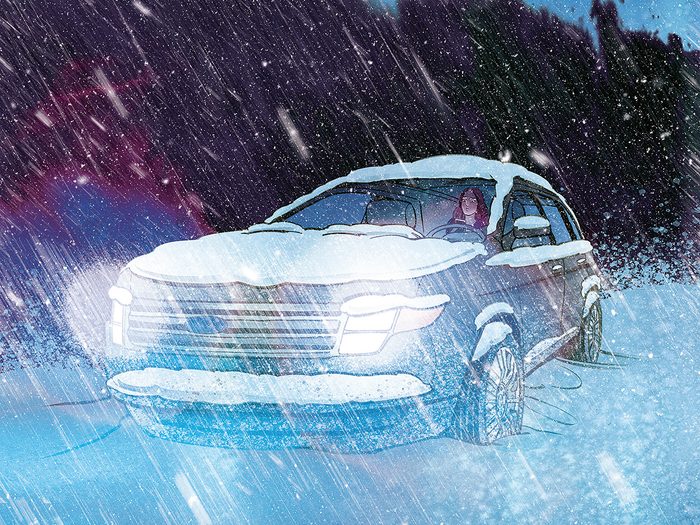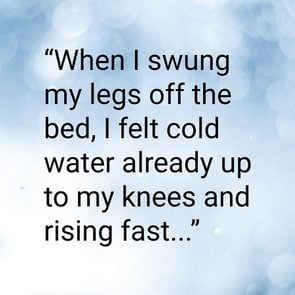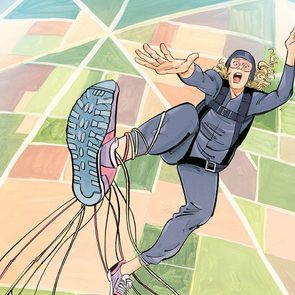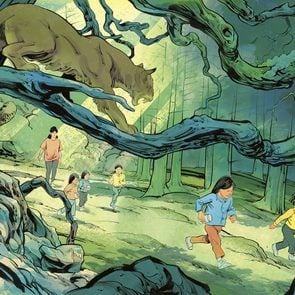How I Survived a “Snownado” While Trapped in My Car

Stuck at the side of the road in swirling snow and shrieking wind—a phenomenon nicknamed a "snownado"—Shannon St. Onge feared the worst.
The snowstorm was supposed to hit on the evening of Monday, January 31, 2022. I was working from home but I had to leave that afternoon and go to my office at First Nations University in Regina so I could sign an emergency bursary cheque for a student. As the director of finance, I wanted to get it to him as soon as possible, Saskatchewan snowstorm or not. Besides, I wasn’t worried. I figured I had lots of time to make it to the office and get back home.
The route to the university takes about 30 minutes, straight east along the Trans-Canada Highway on land as flat as a pancake. When I got there, my colleague came to my office to co-sign the cheque, then he left for the day. As I was packing up, I noticed he had left his laptop bag in my office.
“Shoot,” he said when I called him. “I’m already home.”
“I can bring it to you,” I assured him. It was just past 4:30 p.m. The snow wasn’t supposed to start until later, but just to be safe, I decided to use the country roads near his home instead of the highway, which could fast become a skating rink. On the way, I filled up my SUV with gas and picked up two stuffed-crust pizzas because I’d promised my 15-year-old daughter and 10-year-old son I’d bring some home for dinner.
It took me about 15 minutes to get to my colleague’s house, where I dropped off the laptop case and got right back on the road. Then the snow started—and it was coming down fast. Within minutes I was in a whiteout. The storm was a “snownado,” or what the TV meteorologists call a Saskatchewan screamer, because it comes in fast and is so windy that it screams.
It was terrifying!
Hunkering down
The road soon went from paved to gravel, so I had to reduce my speed. I rolled down my window, thinking I could follow the edge of the road and keep to a straight line. But really, I hadn’t a clue where I was or even which side of the road I was on. At one point, I don’t know exactly when, I stopped because I was afraid of driving into a farmer’s field, the ditch or worse. I kept the car running to keep warm and called 9-1-1. The dispatcher told me to sit tight and wait things out for the night—nobody was coming to get me until morning at the earliest.
Those seconds after the call were the worst of my life. Getting out to walk in a whiteout with zero visibility, high winds and a temperature that was hovering around -10 degrees C—when I didn’t even know where I was—wasn’t an option. But I worried other drivers wouldn’t see me and would smash into the car. Or that the tailpipe would get clogged with snow and I’d die from carbon monoxide poisoning. Or that the storm would be longer than predicted and I’d be found too late. Breathe, I told myself. Panicking won’t help.
And my kids! It was the first time they’d ever be spending a night without me at home. I called and told them what was happening, forcing myself to sound calm. I didn’t tell them I was terrified. That I, a problem solver all my life, couldn’t figure out what to do.
It was now about 6 p.m. and dark. What would my black SUV look like in a whiteout at night? Would it appear as a shadow? Or worse, would it be invisible? Suddenly a truck drove by, barely missing me. It was close. At first, I was scared. But then I thought, salvation! I put the car in drive and followed the truck, desperate, driving slowly with no idea where we were going. When it suddenly turned, I didn’t know what to do.
“I’m going to the beach,” the driver shouted through his open window, his words almost lost in the wind.
I knew the beach wasn’t in the direction of my home. I had no idea where I was. So I stopped the car and texted my colleague whose laptop bag I had just returned. I joked about my good deed ending in disaster. But he had an idea. “Pin your location on Google Maps and send it to me,” he said.
I did, and a few minutes later he texted me back a screenshot of the satellite view of where I was. We figured out that I was on a road called Bouvier Lane, in between two farms. It was now 6:30 p.m. I posted this new information to my Facebook community group, pleading for anyone who knew who lived on the farms to help me get rescued.
After that, all I could do was sit in the car and try to stay warm. I was so glad that I’d just filled it up. I’d done all I could, and no matter what happened, I had to be at peace with that. But even if someone did figure out where I was, would help be able to come through the swirling snow and shrieking wind?
Help arrives
Soon enough, though, people started chiming in on my post. They knew the family who lived there! I got a message from someone who was going to put me in touch with them. At 8 p.m., my cellphone rang. It was the son of the farmer who owned the land beside the road I was stranded on. He told me that his dad was coming to get me!
Then, about 45 minutes later, I saw a tall figure in a yellow rain slicker striding toward me in the dark, carrying a flashlight. Oh my gosh, was I relieved to see him! It was André Bouvier, who’d walked half a kilometre through the blizzard to come get me, fighting the wind and snow each step of the way, shielding his eyes from the stinging snow with a mittened hand.
“Can you drive?” I asked, shakily, through the car window. “My nerves are shot.” Despite his strong stride, now that he was close up, I realized he was an elderly man.
“No,” he replied, his voice steady. “I want you to follow me in your car. You’ll be okay.”
He turned around and started to trudge through the snow, sure of the direction. I drove slowly behind him, clutching the wheel, feeling my heart begin to beat more slowly. When we reached the house a few minutes later, I got out of the car and burst into tears, all my fears turning into relief and gratitude.
Safe and sound
As his wife treated me to hot drinks and apple sauce, André, who I’d learn was 80 years old, said he’d noticed two other cars stranded, too, and he went back out into the storm to get them: a father and his two kids and a couple with their daughter. That’s the kind of guy he is: a guy whose energy and outlook is so much younger than his actual age.
We all spent the night telling stories, the kids ate the pizza I’d bought, and we slept scattered around the house, on sofas and La-Z-Boy chairs. By 5:30 the next morning, André had cleared the snow from his driveway enough that we could all get out and drive home, which in my case ended up being only five minutes away. The storm turned me around so much, I didn’t realize how close I was. Even so, I couldn’t have gone any further without risking my life.
The experience gave me a new perspective, letting me approach challenges and surprises with a sense of calm. It reminded me to always reach out and help others—both friends and strangers. But best of all, it brought André into my life. We’re still in touch, and I know we’ll be friends forever.
André Bouvier was awarded a Queen Elizabeth II Platinum Jubilee Medal for his “outstanding service and citizenship” that night.
Next, read this terrifying true story about a man trapped in his basement during a flash flood.






